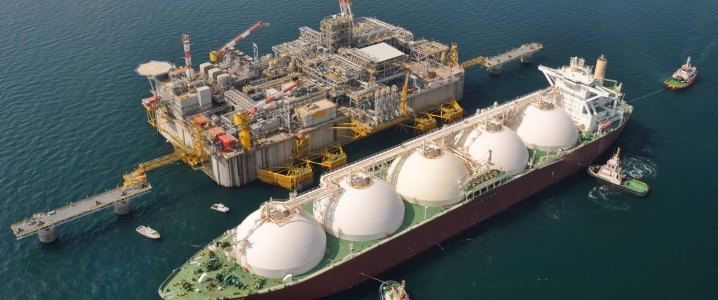The Arab world is blessed with some of the most impressive hydrocarbon reserves in the world, but despite impressive domestic reserves, production has failed to keep pace with rising consumption. Because of this, the Middle East and North Africa region or MENA will become the world’s second largest importer of LNG in the coming years according to the International Energy Agency, with consumption rising from 480 bcm in 2015 to 738 bcm in 2040.
Algeria was a pioneer in using LNG technology with the world’s first liquefication plant in 1964. The MENA has come a long way since the early days of the industry. Until 2015 almost 50 percent of the worldwide nominal LNG production came from the region. Resources, however, are unevenly distributed. While some countries possess significant reserves, such as Qatar, others rely on imports to meet demand.
Egypt went from the world’s eighth largest exporter of LNG in 2009 to the world's eighth largest importer in 2016. However, Cairo’s fortunes have changed again due to the discovery of a massive gas field off its coast in the Eastern Mediterranean. Others, such as the UAE, possess significant reserves, but rely on LNG to meet peak demand during the summer. Qatar, on the other hand, is slated to remain the largest LNG producer for the foreseeable future. Doha recently lifted its self-imposed moratorium on production regarding its North Dome gas field, the single largest field in the world.
Growing demand for LNG
MENA’s growing energy demand is caused by natural reasons and changes in government policies. The population is slated to double until 2050. Logically, more people require more energy to power homes and factories. Lagging domestic production needs to be supplemented by LNG imports in order to keep the economy going.
Government policies have created incentives to increase natural gas consumption due to its advantages compared to other fossil fuels. The price of LNG fluctuates on basis of the same economic fundamentals of supply and demand as with other products. Costs decreased significantly in 2013-2014 amid a sharp rise in upstream liquefication capacity and weak demand in some parts of the world. Related: Energy Earnings Pull Trinidad And Tobago From Recession

According to some analysts, a ‘supply glut' was to persist until mid-2020. Beijing’s coal-to-gas policy, however, mitigated some of the gloom thinking with an increase in demand by 25% in 2018. China is now the second largest natural gas importer in the world after Japan and is slated to claim the title of largest LNG importer in 2019.
Financial gains for MENA
LNG’s appeal increased after prices dropped significantly in 2013-2014. In the MENA region, heavy fuel oils and diesel are important sources of energy for power production. Besides the heavy pollutant nature, financial arguments have strengthened the need for more LNG. It makes economic sense to switch to less pollutant fossil fuels when the price divergence compared to other sources of energy is significant enough.
Furthermore, the usage of LNG for the purpose of power production offers another financial advantage to the oil-rich MENA countries. Using LNG to substitute domestically sourced fuels means that more oil is available for buyers on the international market. Buying cheap natural gas and selling more expensive oil creates a financial advantage. Related: Soaring U.S. Oil Production Forces Prices Down
Lastly, MENA’s wealth in abundant sunshine offers another financial benefit. The region suffers from extremely high temperatures during the summer and more mild weather in the winter meaning energy consumption peaks in the warmer months. Globally, LNG demand is at its highest when winter hits the densely populated northern hemisphere including Europe, China, and North America. Therefore, the MENA region is able to take advantage of a relative drop in prices when demand weakens globally during the summer.
Confrontation and changing policies
While the region is awash with natural gas resources, LNG has become a staple fuel. The relatively small distances between resource rich and resource poor nations are ideal for pipelines. Transportation of natural gas using LNG technology becomes economically favorable when the distance is more than 1900 miles or 3000 km. However, political disagreements and government policies have prevented the construction of infrastructure.
The blockade of Qatar by Saudi-Arabia and the UAE is a major impediment of getting energy from the richest Arab country in terms of natural gas resources to its neighbors. Egypt, on the other hand, has chosen to focus on the international LNG market instead of tying itself to a single or limited number of customers regarding pipelines.
Despite impressive growth, LNG imports to the MENA region could decrease on the medium-term. The wealthy Gulf countries have plans to construct nuclear power plants. Besides higher energy demand, Iran’s nuclear program has increased the need with Arab states to keep up. Also, the region is rich with sunshine which has put renewable energy on the agenda of most countries. Finally, the reinvigorated Egyptian LNG industry will change the situation for the most populous Arab country. The discovery of major gas fields has made LNG imports superfluous.
By Vanand Meliksetian for Oilprice.com
More Top Reads From Oilprice.com:
- OPEC's Radical Strategy Change After The Midterms
- Cold Snap Could Send Natural Gas To $5
- World’s Cheapest Natural Gas Market Could Be Facing A Shortage


















